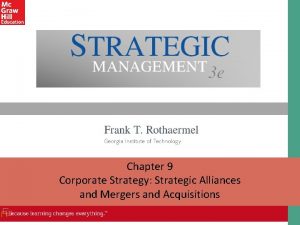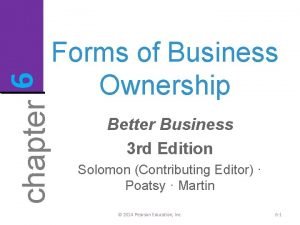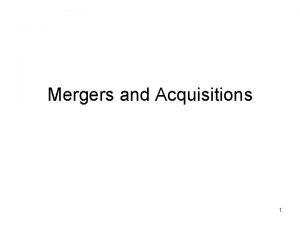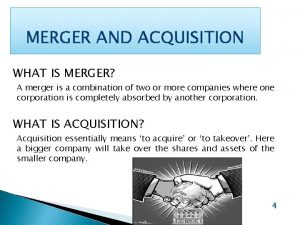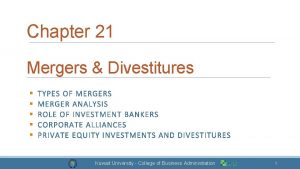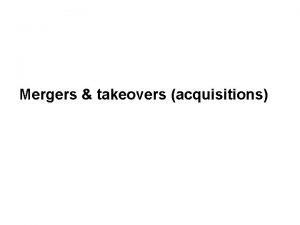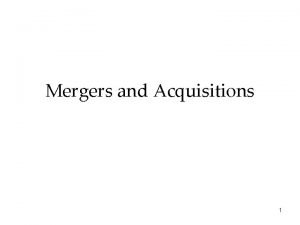MERGERS ACQUISITIONS WHAT IS MERGER A transaction where













- Slides: 13

MERGERS & ACQUISITIONS

WHAT IS MERGER ? “A transaction where two firms agree to integrate their operations on a relatively coequal basis because they have resources and capabilities that together may create a stronger competitive advantage” All combining firms relinquish their individuality and independence to create a new firm. It generally occurs between companies of smaller size and there is high degree of cooperation and interaction between the partners.

Types of merger • Horizontal merger- two or more firms from the same field. • Vertical merger – integration of companies with supplementary relationship • Conglomerate merger -unification of different kinds of businesses under one flagship company

ACQUISITION/ TAKEOVER The meaning of acquisition is that when one company acquires the total or at least controlling amount of stake of another company. The acquired company acts as part of the acquiring company. The separate identity of the acquired company is lost and it is absorbed within the administrative framework of the acquiring company. Firms often tend to be of unequal size and the smaller firm is expected to surrender its independence to the other.

Characteristics of acquisition: • • Separate entity Transfer of ownership Occurs between unequal size of company Willingness may or may not required

Types of acquisition : 1. 2. • • Friendly- Management of both the companies agree mutually for takeover. Hostile. An aggressive firm tries to acquire the firm against the latter’s desire. Linked with poor management and performance In cases where chances of making profits exceed the cost of takeover considerably. Promoters with less than 50% stake.

Examples of acquisition : • Vodaphones acquires Hutchison • Ranbaxy acquires the fifth largest pharmaceutical company of Romania • VSNL acquires Tyco. • Tata Motor acquires Daewoo Commercial vehical • Reliance Industries acquires IPCL

REASONS/RATIONALE FOR MERGER AND ACQUISTION • • Large size- economies of scale Increase Revenue Increase Market Share Tax advantages Diversification Empire Building Increase In market share which can increase market power

• • Growth Monopoly power and scale of economics Geographical Expansion Mode Access to new customer base Elimination of competition To extend there product line When you cannot defeat your enemy make him your friend

Legal Procedure for Merger & Acquisition… • Verify the ‘Object Clause’ of Memorandum of Association. • Intimation to stock exchange. • Approval of Board of Director. • Sanction of High Court is required.

Contd… • 75% of creditors & shareholder must give their approval. • Copies will be filed with registrar. • Purchase consideration will paid according to agreement.

SEBI GUIDELINES • Takeover code- a set of rules & guidelines framed by the market regulator SEBI to define the role of investors and shareholders in companies whenever their holdings in a particular company increase to a specified level. • Objective- To ensure that whenever there is acquisition of a significant stake in the company with or without a view to change the management or control the management, minority shareholders or even other shareholders get a fair deal in terms of price for their holdings. • Defines the percentage of equity that an existing promoter can acquire during a single year to increase his stake. If a promoter decides to increase his stake beyond the prescribed limit, he would have to make open offer at the same price at which he is acquiring.

PROBLEMS IN M & A • • • Unpredictability Managerial mistakes Deal structure Compensation Protecting the customers’ interest Cultural compatibility
 Radiology mergers and acquisitions
Radiology mergers and acquisitions Mergers in strategic management
Mergers in strategic management What is mergers and acquisitions
What is mergers and acquisitions Hr issues in mergers and acquisitions
Hr issues in mergers and acquisitions Mergers and acquisitions rumors
Mergers and acquisitions rumors Franchise mergers & acquisitions advisors
Franchise mergers & acquisitions advisors Forbes mergers & acquisitions
Forbes mergers & acquisitions What is corporate restructuring
What is corporate restructuring Equity strategic alliance example
Equity strategic alliance example Better business forms
Better business forms Tech sector mergers
Tech sector mergers Avoid mergers photography
Avoid mergers photography Merger vs acquisition
Merger vs acquisition Gregor andrade
Gregor andrade








